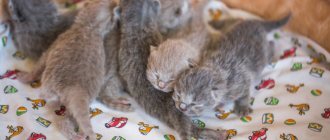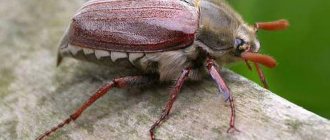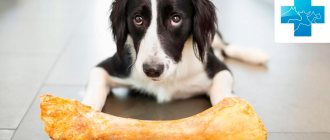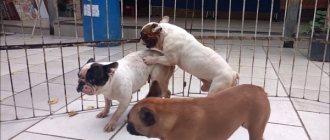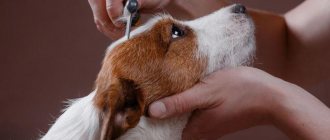Caring for a puppy at 1-2 months
If necessary, babies have their ears or tails docked in the first 2 weeks. This is due to the low pain threshold and rapid regeneration, which are lost within 4 weeks after birth.
Animals are breastfed until 2-2.5 months. Together with colostrum, maternal immunity is transmitted to them, so before switching to regular feeding, care must be taken to obtain all mandatory vaccinations.
First feeding
At the 3rd week of life, complementary foods are added to the diet: grated vegetables, slimy porridge and minced meat ground into a puree. Products with a high calcium content (cottage cheese, kefir) are introduced after 1.5 months. An alternative is special food for babies.
First vaccinations
At 2 months, the first vaccination against parainfluenza, infectious hepatitis, enteritis and leptospirosis is given. A little later, the baby is vaccinated against distemper and rabies. Sometimes they resort to a complex vaccine.
When to deworm
Before vaccinations, the dog is treated for parasites. You cannot use any folk remedies: horseradish, garlic, wormwood, etc. They are ineffective and can lead to poisoning. Therefore, it is worth buying a special drug from a veterinary pharmacy. It is advisable to choose products that are intended specifically for children, otherwise adult dosages will lead to poisoning.
The genuine medicine contains instructions for use.
The specific scheme depends on the product. For example, Milbemax is given at 2, 4 and 8 weeks, and Pirantel at 4-8-12 weeks. In any case, you should contact your veterinarian.
Moving a baby to a new home
Before your four-legged family member arrives, be sure to take care of safety. Remove all potentially dangerous objects from the floor, hide wires, insulate the trash can and protect the windows. After that, start purchasing the necessary things and direct adaptation.
Buying necessary things
The baby will need 2 bowls for food and water, grooming tools, ammunition, toys, absorbent diapers or a tray. Choose products made from durable and safe materials: ceramics and metal for bowls, nylon or tarpaulin for a collar. For small and medium-sized dogs, you can purchase a carrier.
Arrangement of the place
Arrange the sleeping place in the warmest room to avoid hypothermia of the four-legged one. Remove all carpets and install a small, spacious enclosure. With its help, you can limit the movement of your pet during your absence.
The place to sleep should not only be warm, but also comfortable and dry. If there are other animals in the house, make sure that each of them has their own personal bed or house. This will eliminate the occurrence of conflicts.
Adaptation to a new home
At first, the baby will miss his mother, so stay close to him and do not forbid him to sleep in the same room with you. To avoid aggression from other pets, limit the available space to only one room or enclosure. Let the other four-legged animals get used to the unfamiliar smell and only then introduce them to the little “recruit” face to face.
Exploring a new territory is best done under your supervision, right up to toilet training. Otherwise, the baby will definitely leave puddles.
Feeding
Immediately after the move, use the same food as the breeder. Switching too quickly to a new type of feeding can lead to digestive upset.
Mix new food into old food gradually, gradually increasing the amount of unfamiliar food. This may take up to 2 weeks, so take your time.
For comfortable development, babies need a lot of protein, calcium, unsaturated fatty acids and other useful elements. The recommended diet may vary depending on the breed, so be sure to consult your veterinarian to avoid vitamin deficiencies.
Upbringing
Stop permissiveness from the first days of the baby’s appearance in your home. Correct unwanted behavior and do not violate your own prohibitions.
Build your learning in a playful way, but don’t forget about firmness and perseverance. Otherwise, your authority will be undermined even before teenage stubbornness appears.
Try to choose a name as soon as possible and refer to your pet by name often. Smart kids can get used to the nickname in 1-2 weeks. Other brats will take about 3-4 weeks.
Preparations for the meeting
With the addition of a four-legged creature to the family, changes in the interior of the apartment are inevitable. When a little dog arrives in the house, you should prepare everything you will need for the first time:
- a set of bowls for food and drink;
- litter tray;
- grooming tools;
- outdoor accessories (leash, collar, overalls for the cold season);
- “chewing” elastic toys (with them the puppy will be able to “scratch” the gums, from which the first milk teeth will erupt);
- repellent spray, the smell of which will correct the behavior of the ward, who loves to gnaw and scratch everything.
You should build a cozy dog house for the new guest. A soft rug or mattress will cope with this role. The lounger should be in a warm and quiet place, away from medications, electrical wiring, piercing and cutting objects.
From the breeder you need to take not only documents confirming the dog’s pedigree, but also detailed information about the health and features of caring for the newborn. The following information will be helpful:
- what ailments afflicted the cub’s parents;
- how the birth proceeded - with or without complications;
- whether the breeder gave the puppy the first complementary foods and where he started;
- what kind of litter the dog is accustomed to;
- whether immunization was carried out, what vaccinations were given and when;
- when was the kitten dewormed for the first time, how much time passed after the last deworming.
It would be a good idea to get the veterinarian’s phone number in advance.
Caring for puppies up to six months
Caring for a puppy from 2 to 6 months is no longer limited to feeding alone. After vaccination, the pet is accustomed to the street and begins to train.
First walk
Going outside becomes possible after quarantine. Until this moment, the dog is walked strictly in arms or in a closed area in the courtyard of a private house.
Quarantine lasts 2 weeks after the last mandatory vaccination. The thing is that the body takes a lot of effort to produce antibodies. During this period, the immune system is weakened and vulnerable to harmful microorganisms.
Before the first walk, be sure to teach your baby the equipment and basic commands. Remember that the tension on the leash must be stopped on both sides. The animal must walk on a loose leash close to its owner.
Feeding
The number of feedings and the diet itself depends on age. Up to 4 months the animal is fed 4-5 times a day, and from 4 to 6 months - 3-4 times a day. With natural nutrition, fresh cabbage and boiled sea fish are added to complementary foods. A puree-like consistency is welcome until all the molars appear.
For industrial feeding, ready-made food in the form of spiders or canned food is used, as well as dry granules soaked in warm water. All proportions are selected individually based on the weight, age and breed of the animal.
Please note that when switching to independent feeding, you must completely eliminate milk. As dogs get older, they develop lactose intolerance, which can lead to diarrhea and vomiting.
What skills should a dog master?
Proper care of a puppy includes training, accustoming to various hygiene procedures and wearing equipment. From 2 to 4 months, the pet must remember its name and place, learn to go to the toilet outside, and also get used to combing its fur, trimming its claws, and wearing a leash with a collar.
By six months, the list of skills is supplemented with the following commands:
- "To me";
- "Near";
- "Sit";
- "Lie";
- "Stand";
- "It is forbidden";
- "Ugh".
If during training serious problems arise that impede the acquisition of skills, sign up for courses at a canine club. For companion dogs, it will be enough to pass the UGS. For everyone else, OKD is more suitable, serving as the basis for more complex courses.
What should you wean your pet from?
The educational process is built not only on accustoming to something, but also on weaning off unwanted behavior. These include:
- Begging. Feed your dog at separate times and ignore any attempts to beg for food from your table.
- Chewing furniture, shoes and other objects. Use a special repellent spray and buy more chew toys.
- Picking up from the ground. Stop this behavior with the command “Fu” and walk with a muzzle until the four-legged dog learns to respond to it.
Please note that you must be at one with all family members. If one of your compassionate relatives periodically feeds the dog from his plate, your educational efforts will never yield results.
Revaccination
Revaccination, or re-vaccination, is carried out 21-28 days after the main one. Its main task is to increase the amount of antibodies necessary to protect the body.
Ensuring Healthy Potty Time
A healthy one-month-old puppy should eliminate waste on its own and attempt to clean itself. However, if you see that he is unable to go potty, you will need to encourage your little one to urinate and defecate after meals by wiping his genitals with a washcloth or cloth soaked in warm water. This is especially important to prevent constipation in puppies if they do not eliminate their stool regularly. As far as potty training goes, that won't start for a few weeks.
Caring for puppies up to 1 year old
Caring for puppies after six months means becoming familiar with the problems associated with puberty. During this period, the owner needs to think about castration or sterilization.
Puberty
Sexual maturity occurs at 6-8 months. At this age, the first estrus and the first sexual heat occur. The dog behaves more aggressively towards other males and shows increased interest in the opposite sex.
If you do not plan to participate in breeding, sign up your pet for surgery. It has a beneficial effect on the animal’s behavior and serves as a prevention of cancer pathologies.
Teenage stubbornness
Along with puberty comes stubbornness. Due to hormones, the pet becomes willful under any restrictions, trying to undermine the authority of the owner. He refuses to follow commands and often gets into fights with other animals.
The radical solution to the problems that have arisen is castration. In all other cases, you should be patient, since education and socialization will have to be dealt with from the very beginning.
Features of feeding
After six months the dog is switched to three meals a day, and after a year - to two meals a day. More protein is added to the diet in the form of raw or boiled meat and offal. There is no need to grind food anymore, as the pet has permanent teeth. If you use ready-made food, you can smoothly switch to an adult diet of the same brand that your four-legged eats.
Basic rules for proper feeding of newborns
- The position of babies during feeding is lying on their tummy with their head slightly raised. It is convenient to cover your knees with a soft cloth or towel and sit the kitten/puppy on your legs.
- You should feed only freshly prepared artificial formulas or homemade ones, stored for no more than a day in the refrigerator.
- Be sure to wash your hands with soap before feeding - this will help avoid bacterial stomach upset.
- Any containers used for feeding newborn animals must be boiled for at least 5 minutes. Most often, pipettes, syringes or special bottles and nipples are used, sold in pet stores, veterinary pharmacies or included with breast milk substitutes. Pipettes and syringes should be used with great care, because... Too rapid flow of milk/formula may cause inhalation of food droplets and the development of pneumonia.
- The mixture can be heated in a water bath, or in the microwave. The food temperature should be between 37-38°C in the first 1.5-2 weeks, and then it is brought up to 26°C by the end of the first month of life.
- If a puppy/kitten takes the pacifier and spits it out, it is necessary to open the mouth, lightly pressing on the edges of the jaw, and drop a few drops on the tongue so that the babies feel the taste of the food and understand that they need to suck.
- Bottles/syringes/droppers should be held at approximately a 45° angle.
- Do not press on the container to speed up the feeding process!
- While feeding, stroke the baby's forehead and back - this will stimulate sucking.
- A fed baby lets go of the pacifier and calmly falls asleep, a hungry baby will continue to squeak and look for food.
- After feeding, kittens/puppies must defecate - it is important to monitor this.
- Feeding must be done strictly on time. If babies are sleeping, you should gently wake them up and start feeding them a little at a time.
- Any deviations in the feeding process: refusal of the pacifier, milk coming through the nostrils, restless behavior, unreasonable meowing/whining - this is always a reason to show the babies to the veterinarian and find out what is the reason for this behavior!
What both a puppy and an adult dog need
It is necessary to note several points that do not depend on age. These include hygiene, drinking regime, vaccinations and routine examinations, as well as treatment for parasites and regular walks.
Hygiene of eyes, ears and teeth
Caring for a puppy and an adult dog is not complete without periodic cleaning of the eyes, ears and teeth. Carry out an external inspection daily and watch for the appearance of foreign secretions.
Be sure to remove plaque that accumulates in the corners of the eyes and clean the ears from dirt using lotions or cotton pads.
Thorough teeth cleaning is carried out 1-4 times a month. To do this, use veterinary paste and a small toothbrush. The rest of the time, it is enough to give your pet special treats and chewing toys to prevent the formation of tartar.
Drinking regime
The average norm for dogs is 100 ml per 1 kg of weight per day. The exact amount depends on the size, age, gender and diet of the animal. Large young bitches on dry feeding require the most water, and small older males on natural food require the least amount of water.
Be sure to change the water in the bowl 1-2 times a day. If you use water straight from the tap, don't forget to filter it.
Vaccinations and routine health checks
After 1 year, all subsequent vaccinations are given 1-3 times a year, depending on the animal’s health. Routine health checks are equally important. They are carried out 1-2 times a year.
Treatment for parasites
Treat for internal parasites (worms) every six months, and for external parasites (ticks, fleas) during periods of maximum activity. It is better to entrust the choice of antiparasitic agents to a doctor. Due to their toxicity, it is very important to consider the age and health of the quadruped. The most gentle medications are selected for babies and pregnant females.
Sensitivity is more important than vitamins
In order for a puppy to grow up sociable and gentle, he needs maximum attention from the first days of life. It would be nice to take a vacation, at least for a week, by the time he arrives in the house. Everyday care, hourly feeding, and the tireless process of education are guarantees of establishing friendly contact between the puppy and the owner.
After all, a 4-8 week old baby not only needs to get comfortable in a new home, sniffing every corner. He must figure out who belongs here and who is a stranger, who can be trusted and who should be wary.
Creating a warm, calm atmosphere in the house is a key task in caring for a small puppy. He, separated from his mother and the company of his brothers and sisters, needs a new family circle where everyone feels comfortable and secure.
Industrially produced breast milk substitutes
There are special formulas or “artificial” mother’s milk for feeding newborn kittens and puppies. The cost of these products is quite high, but experts recommend them for use by children.
Options for cat milk substitutes:
- Beaphar Kitty-Milk (650 RUR/200 g);
- Canina Katzenmilch (RUB 1,500/450 g);
- Trovet Kitten Milk KMS (RUB 1,100/400 g);
- Babycat Milk Royal Canin (RUB 1,100/300 g);
- Gimpet Cat-Milk (RUB 2,400/2 kg);
- Dr.Clauder`s Katzenmilch (1150 RUR/90 g).
Options for milk replacers for bitches:
- Beaphar Puppy-Milk (650 RUR/200 g);
- Canina Welpenmilch (RUB 1,200/90 g);
- Babydog milk Royal Canin (1000 rub./400 g);
- Nutri-Vet Milk Replacement (RUB 1,160/340 g);
- Hartz Precision Nutrition Powdered Milk for Puppies (RUB 780/340 g);
- Brit Care Puppy Milk (640 RUR/250 RUR).
All mixtures are diluted according to the attached instructions, taking into account the age of the babies and their weight at a given time.
Practicing veterinarians sometimes advise adding a little more water than indicated in the instructions - this will avoid constipation, because. In some cases, artificial nutrition can strengthen.
Disadvantages of artificial feeding
Artificial feeding of newborn puppies or natural feeding? Sometimes this choice is not even before the owner. The mother does not have milk, she may get sick or even die during childbirth. In such cases, the newborn puppy is transferred to artificial nutrition.
As an option, you can find a recently bristled bitch and place the babies on her so that she can feed them. The "foster" dog should be similar in size to the puppies' mother, and her litter should not be very large, otherwise there will not be enough milk for everyone. This option is quite good, since the baby will receive both food and care, the dog will teach him the basics of behavior and teach him to be independent.
If this is not possible, it is necessary to resort to extreme measures. Artificial feeding has a number of disadvantages. Let's consider the main ones:
- takes a lot of time, attention and effort of the owner. A person doing this for the first time will need the help of experienced breeders or advice from veterinarians. You should not ignore the advice, since with such feeding there is a high risk of losing the animal.
- artificial formulas (even very good ones) are worse than maternal nutrition. Puppies may not tolerate an unnatural diet well. If you feed formula to a newborn puppy, he will not receive the necessary vitamins and protection against infections (antibodies transmitted through mother's milk). When preparing such mixtures yourself, do not forget about fortified supplements.
- “artificial” puppies often have a bad character - the bitch cannot teach them anything, and they also do not have the maternal warmth and care they need so much. The upbringing of the mother is very important: the puppies should feel safe, get used to being independent by one month, and by two months the mother is already teaching them correct behavior, punishing them for “misdemeanors.”
The main and only positive point is that an owner who uses artificial feeding can develop a very close bond with the pet from a young age.
Finding another lactating female
The first option to solve this problem is to find another lactating bitch and place the puppies with her. In such a situation, you need to know some tricks, because the dog may refuse to feed puppies that are not its own.
- In the absence of the wet nurse, it is necessary to mix her puppies with step ones. This is done by placing the puppies one at a time - one of your own, one of someone else's, and so on. This is necessary so that other people's puppies acquire the same smell as her own puppies.
- Afterwards, you need to start the nursing female and place all the puppies under her as quickly as possible. There are cases that bitches are very aggressive towards other people's puppies, so it is better to put a muzzle on her before the first procedure. In it, she will not be able to harm the puppies, as well as the person who started all this.
- After attaching the puppies, you need to remove the muzzle from the dog and, holding it by the collar just in case, watch it. If she begins to lick all the puppies, then the procedure was successful and you don’t have to worry anymore, she mistook strangers for her own. If a dog, after removing the muzzle, tries to harm other people's puppies, you need to take it away for 10-20 minutes, and then repeat it all over again.
IMPORTANT! Until the dog has licked all the puppies, do not leave them alone under any circumstances. Otherwise, she may bite them to death.
Aspects of education
Sometimes, with the best of intentions, new owners do too much to relieve the puppy from the stress of separation from its mother. This applies to being with the baby every minute, feeding in places not intended for eating, constantly being carried in arms and other things.
You should understand: the puppy will grow up, but the habits will remain.
The older the dog gets, the less affection his pranks cause, and over time, the dog still begins to instill good manners. Late socialization and learning the rules of behavior in the house are painful for animals and traumatic for the psyche.
Prioritization or who is boss in the house
In order for the puppy to learn from the first days the arrangements in the “pack”, where the leader will be a person, you need to adhere to some rules:
- Both the dog and the owner have the right to privacy. You cannot spend all your free time with the puppy - the puppy must be able to occupy itself. After playing with your pet, you should leave him alone and go about your business. You can defiantly ignore him for a while: the baby will calm down and stop bothering you.
- You need to teach your dog to stay home alone. You need to do this from the first day, going out the door for a few minutes. It is important that the puppy sees this happening and does not sleep during this time. Over time, the “care” intervals are increased, but no more than an hour in the first few days. During the period when the baby is left alone, he should be well-fed and play enough.
- From the first days, the puppy needs to arrange a place to rest and eat: he must learn to understand that the apartment is divided into certain zones, each with its own functionality. If the feeding place is chosen in the kitchen, it is wrong to expect that the dog will not subsequently go there whenever he wants.
- The dog eats after the owner. This is a very important rule, which subsequently eliminates many behavior problems, especially in “serious” dog breeds. The dog must see that the person (leader) is eating. This is the order of the pack among wild relatives, and domestic animals are no different genetically from them.
- The owner goes up the doors, openings, and stairs first. The puppy will not learn this rule from the first day, but from the moment training begins, you need to remember it, since it is included in the list of priorities.
Such aspects of education do not violate the norms of morality and morality, and the dog will not love its owner less if it learns them. Raising a puppy does not mean its humiliation or infringement of the animal's rights. It is aimed at comfortable coexistence between humans and dogs in society and is designed to ensure, in particular, the safety of people living with the pet.
Place training
Your puppy should have a place where he can feel safe and rest without worrying about someone stepping on him or kicking him out of the way. As a rule, dogs like special beds that are sold in pet stores, but you can also easily design them yourself. Small breeds of dogs are provided with houses, while very large dogs often do without bedding at all. The lounger is arranged in a non-accessible area of the apartment, away from drafts.
In addition to the rest function, the place for the dog has another purpose: it is a certain point where the puppy can be sent if he is in the way or gets naughty. Determining a place for a dog is very important: it increases self-esteem, since a smart owner respects not only his freedom, but also his dog’s personal space.
Teaching a puppy the “place” command is not difficult. At the moment when he has had enough of playing and has practically fallen asleep, he needs to be taken to the mat and told “place!” The command is also repeated during the puppy’s attempts to explore the bed. Fixing the location with a voice will be imprinted in the dog’s memory over time. You can accustom him to his place from 2 months.
Important: it is wrong to try to strengthen the team with food by placing treats on the bedding. The dog is not fed where it sleeps; conflicting commands can confuse the pet.
Toys
Like all children, puppies should have their own toys. Their presence is very significant:
- They protect things and objects in the apartment from destruction, because teething requires a product that can relieve the itching, and often without the opportunity to chew a tasty toy, puppies spoil clothes and furniture.
- Toys help brighten up the puppy's lonely hours when the owners are not at home.
- This is a great way to keep your pet in good physical shape and a means of training the mind: many modern toys are created specifically for this purpose.
Provide security
Before you bring your puppy home, you need to take some safety precautions to prevent him from harming himself:
- Hide all electrical wires, because the pet will study the world around him, including with the help of his teeth;
- Remove breakable objects higher that the puppy can drop or knock over;
- Hide bottles with household chemicals;
- Make a trash can inaccessible to him or purchase a heavy and tall bin.
If necessary, you can even fence off part of the home with a partition so that the puppy can only move around a safe area.
Buy toys
Puppies grow and develop, they are full of energy, and it is best to channel it in the right direction so that furniture, shoes and other items not intended for play do not suffer. To avoid unpleasant surprises, you should buy your pet more toys.
The main thing is that they are safe: in particular, that small parts cannot be bitten off of them, which can be a choking hazard. Some animals are delighted with toys with squeaks, but be prepared to put such items away every night where the puppy cannot reach them. Due to his age, he will not yet understand why he should not play or make noise at night.
Health of the Central Asian Shepherd
This breed is prone to a number of diseases:
- obesity;
- disorders of the cardiovascular system;
- diseases of the musculoskeletal system;
- skin lesions;
- cryptorchidism, infertility, albinism, fusion of the eyelids, diabetes mellitus (all of them are hereditary);
- parvovirus.
The Central Asian Shepherd Dog does not require much attention in terms of hygienic care and maintenance. But due to their stubborn and independent nature, even simple grooming activities can become a problem.
From any point of view, this breed is intended only for experienced dog owners who lead an active lifestyle and know how to handle a proud and intelligent animal.
Self-feeding
What can you feed newborn puppies? Bitch milk substitute mixture. This can be bought at pet stores. Several manufacturers produce formulas for puppies; Beaphar and Royal Canin are considered the best. What to feed your baby before buying a milk replacer? There are lifesaver recipes for this case. But keep in mind that they cannot be used constantly. The basis of homemade formulas is cow's milk. It is less fatty and nutritious than dog food.
